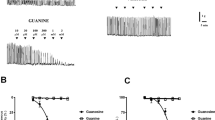Abstract
Risperidone is an antipsychotic commonly used during pregnancy. Because it can cross the placental barrier, our objective was to evaluate its actions on the smooth muscle of the human umbilical artery (HUA). Risperidone preincubation (1–300 nmol/L for 20 minutes) produced a significant decrease in maximum force development induced by serotonin or histamine in HUA rings. When applied on top of stable contractions induced by these agonists risperidone produced quick relaxations (IC50 = 1 nmol/L for serotonin and 72 nmol/L for histamine). Risperidone induced the contraction of vascular rings depolarized by 40 mmol/L extracellular K+ but not in the case of 80 mmol/L K+, suggesting inhibition of K+ channels. The patch-clamp technique showed that risperidone (3 nmol/L) inhibited whole-cell K+ currents in freshly isolated HUA smooth muscle cells. Our results are the first showing risperidone effects in human vascular smooth muscle and highlight that its use during pregnancy should be adequately monitored.
Similar content being viewed by others
References
Häfner H, Riecher A, Maurer K, Löffler W, Munk-Jørgensen P, Strömgren E. How does gender influence age at first hospitalization for schizophrenia? A transnational case register study. Psychol Med. 1989;19(4):903–918.
Iveli MF, Rebolledo A, Milesi V. Atypical antipsychotic drugs during pregnancy. Its effects on the mother and on the offspring. Curr Womens Health Rev. 2009;5(2):100–108.
Reis M, Källón B. Maternal use of antipsychotics in early pregnancy and delivery outcome. J Clin Psychopharmacol. 2008;28(3):279–288.
Coppola D, Russo LJ, Kwarta RF Jr, Varughese R, Schmider J. Evaluating the postmarketing experience of risperidone use during pregnancy: pregnancy and neonatal outcomes. Drug Saf. 2007;30(3):247–264.
McKenna K, Koren G, Tetelbaum M, et al. Pregnancy outcome of women using atypical antipsychotic drugs: a prospective comparative study. J Clin Psychiatry. 2005;66(4):444–449.
American Academy of Pediatrics. Committee on Drugs. Use of psychoactive medication during pregnancy and possible effects on the fetus and newborn. Pediatrics. 2000;105(4 pt 1):880–887.
Newport DJ, Calamaras MR, DeVane CL, et al. Atypical antipsychotic administration during late pregnancy: placental passage and obstetrical outcomes. Am J Psychiatry. 2007;164(8): 1214–1220.
Grant S, Fitton A. Risperidone: a review of its pharmacology and therapeutic potential in the treatment of schizophrenia. Drugs. 1994;48(2):253–273.
Bertrand C, St-Louis J. Reactivities to serotonin and histamine in umbilical and placental vessels during the third trimester after normotensive pregnancies and pregnancies complicated by preeclampsia. Am J Obstet Gynecol. 1999;180(3 pt 1):650–659.
Lovren F, Li XF, Lytton J, Triggle C. Functional characterization and m-RNA expression of 5-HT receptors mediating contraction in human umbilical artery. Br J Pharmacol. 1999;127(5): 1247–1255.
Gardner DS, Fletcher AJW, Fowden AL, Giussani DA. A novel method for controlled and reversible long term compression of the umbilical cord in fetal sheep. J Physiol. 2001;535(pt 1):217–229.
Clapp JF, Peress NS, Wesley M, Mann LI. Brain damage after intermittent partial cord occlusion in the chronically instrumented fetal lamb. Am J Obstet Gynecol. 1988;159(2): 504–509.
Christ T, Wettwer E, Ravens U. Risperidone-induced action potential prolongation is attenuated by increase repolarization reserve due to concomitant block of ICaL. Naunyn Schmiedebergs Arch Pharmacol. 2005;371(5):393–400.
Gluais P, Bastide M, Caron J, Adamantidis M. Risperidone prolongs cardiac action potential through reduction of K+ currents in rabbit myocytes. Eur J Pharmacol. 2002;444(3): 123–132.
Magyar J, Banyasz T, Pacher P, et al. Electophysiological effects of risperidone in mammalian cardiac cells. Naunyn Schimiedebergs Arch Pharmacol. 2002;366(4):350–356.
Klockner U. Intracellular calcium ions activate a low-conductance chloride channel in smooth-muscle cells isolated from human mesenteric artery. Pflügers Arch. 1993;424(3–4): 231–237.
Milesi V, Raingo J, Rebolledo A, Grassi de Gende AO. Potassium channels in human umbilical artery cells. J Soc Gynecol Investig. 2003;10(6):339–346.
Hamill OP, Marty A, Neher E, Sackmann B, Sigworth FJ. Improved patch clamp techniques for high-resolution current readings from cells and cell-free membrane patches. Pflügers Arch. 1981;391(2):85–100.
Olesen OV, Licht RW, Thomsen E, Bruun T, Viftrup JE, Linnet K. Serum concentrations and side effects in psychiatric patients during risperidone therapy. Ther Drug Monit. 1998; 20(4):380–384.
Kuroki T, Nagao N, Nakahara T. Neuropharmacology of second-generation antipsychotic drugs: a validity of the serotonin-dopamine hypothesis. Prog Brain Res. 2008;172:199–212.
Sexton AJ, Loesch A, Turmaine M, Miah S, Burnstock G. Electron-microscopic immunolabelling of vasoactive substances in human umbilical endothelial cells and their actions in early and late pregnancy. Cell Tissue Res. 1996;284(1):167–175.
Lang U, Baker RS, Braems G, Zygmunt M, Künzel W, Clark KE. Uterine blood flow—a determinant of fetal growth. Eur J Obstet Gynecol Reprod Biol. 2003;110(suppl):S55–S61.
Lang U, Baker RS, Khoury J, Clark KE. Effects of chronic reduction in uterine blood flow on fetal and placental growth in the sheep. Am J Physiol Regul Integr Comp Physiol. 2000;279(1): R53–R59.
Author information
Authors and Affiliations
Corresponding author
Rights and permissions
About this article
Cite this article
Iveli, M.F., Rebolledo, A., Martín, P. et al. Risperidone Inhibits Contractions Induced by Serotonin and Histamine and Reduces K+ Currents in Smooth Muscle of Human Umbilical Artery. Reprod. Sci. 17, 854–860 (2010). https://doi.org/10.1177/1933719110372420
Published:
Issue Date:
DOI: https://doi.org/10.1177/1933719110372420




